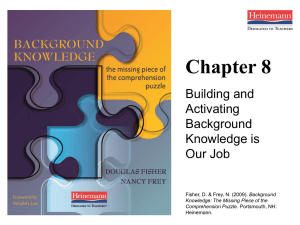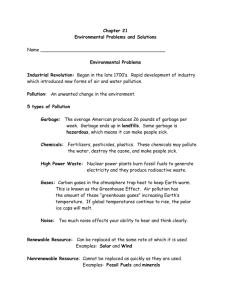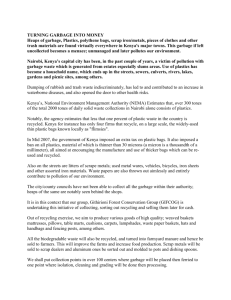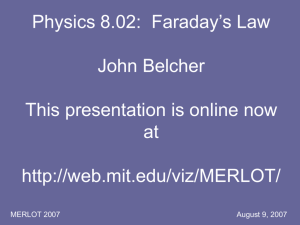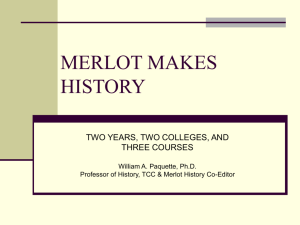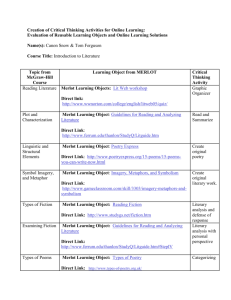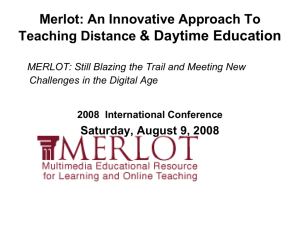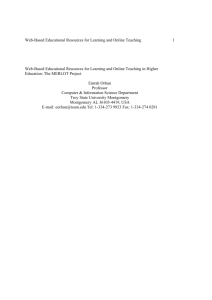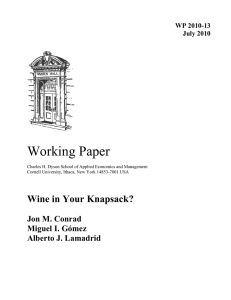Exam 1
advertisement
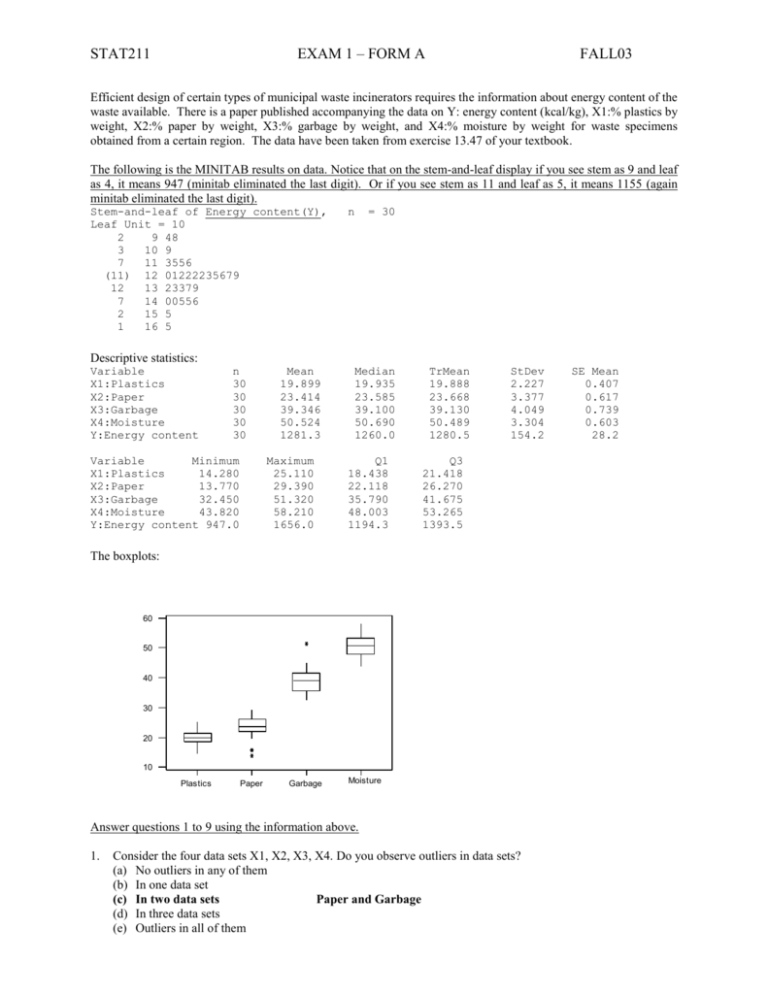
EXAM 1 – FORM A
STAT211
FALL03
Efficient design of certain types of municipal waste incinerators requires the information about energy content of the
waste available. There is a paper published accompanying the data on Y: energy content (kcal/kg), X1:% plastics by
weight, X2:% paper by weight, X3:% garbage by weight, and X4:% moisture by weight for waste specimens
obtained from a certain region. The data have been taken from exercise 13.47 of your textbook.
The following is the MINITAB results on data. Notice that on the stem-and-leaf display if you see stem as 9 and leaf
as 4, it means 947 (minitab eliminated the last digit). Or if you see stem as 11 and leaf as 5, it means 1155 (again
minitab eliminated the last digit).
Stem-and-leaf of Energy content(Y),
Leaf Unit = 10
2
9 48
3
10 9
7
11 3556
(11) 12 01222235679
12
13 23379
7
14 00556
2
15 5
1
16 5
n
= 30
Descriptive statistics:
Variable
X1:Plastics
X2:Paper
X3:Garbage
X4:Moisture
Y:Energy content
n
30
30
30
30
30
Variable
Minimum
X1:Plastics
14.280
X2:Paper
13.770
X3:Garbage
32.450
X4:Moisture
43.820
Y:Energy content 947.0
Mean
19.899
23.414
39.346
50.524
1281.3
Maximum
25.110
29.390
51.320
58.210
1656.0
Median
19.935
23.585
39.100
50.690
1260.0
Q1
18.438
22.118
35.790
48.003
1194.3
TrMean
19.888
23.668
39.130
50.489
1280.5
StDev
2.227
3.377
4.049
3.304
154.2
Q3
21.418
26.270
41.675
53.265
1393.5
The boxplots:
60
50
40
30
20
10
Plastics
Paper
Garbage
Moisture
Answer questions 1 to 9 using the information above.
1.
Consider the four data sets X1, X2, X3, X4. Do you observe outliers in data sets?
(a) No outliers in any of them
(b) In one data set
(c) In two data sets
Paper and Garbage
(d) In three data sets
(e) Outliers in all of them
SE Mean
0.407
0.617
0.739
0.603
28.2
STAT211
2.
What is the range for X1?
(a) 10.83
(b) 14.39
(c) 15.62
(d) 18.87
EXAM 1 – FORM A
FALL03
=25.110-14.280
3.
Which of the following data set has the largest variation using the standard deviation?
(a) X1
(b) X2
(c) X3
(d) X4
4.
Which of the following data set has the smallest median?
(a) X1
(b) X2
(c) X3
(d) X4
5.
Which of those data sets are positively skewed?
(a) Only X1
(b) Only X2
(c) Only X3
if it is not clear on the boxplot look at the difference between the mean and the median
(d) Only X4
(e) None of the above
6.
If you like to add 5 to each observation for X2 (Paper), how much the interquartile range (IQR) changes?
(a) Increase by 5
(b) Stays the same
Q1 and Q3 increase by 5. IQR=Q3-Q1
(c) Decrease by 5
7.
Which of the following is the largest 25% of X2?
(a) 13.770
(b) 22.118
(c) 23.585
(d) 26.270
is the same as smallest 75% of X2 which is Q3
(e) 29.390
8.
Which of the following is the proportion of Y more than 1129?
(a) 0.0333
(b) 0.0667
(c) 0.1000
(d) 0.9000
count the data larger than 1129. There are 27 of them. Then 27/30.
(e) 0.9333
9.
Which of the following is the proportion of Y between 1089 and 1545 (exclusive)?
(a) 0.0667
(b) 0.1333
(c) 0.1667
(d) 0.8667
count the data between 1089 and 1545. There are 26 of them. Then 26/30.
(e) 0.9333
10. What is the reliability for the parallel system of 4 components each with a failure probability of 0.2?
(a) 0.0016
(b) 0.4096
(c) 0.5876
(d) 0.5904
(e) 0.9984
P(at least one works)=1-P(none works)=1-0.24.
STAT211
EXAM 1 – FORM A
FALL03
For a dinner party, the current wine supply includes 3 zinfandel, 4 of merlot, and 3 of cabernet, all from different
wineries. Answer the following 3 questions using this information.
11. If you like to serve 3 bottles of merlot and serving order is important, how many ways are there to do this?
(a) 4
(b) 6
(c) 12
(d) 24
There are 4 merlot and 3 will be served with order. P 3,4=4(3)(2)
(e) 36
12. If 5 bottles are randomly selected, what is the probability that this results in 1 zinfandel, 1 merlot, 3 cabernets?
(a) 12/30240=0.0004
(b) 36/30240=0.0012
(c) 12/252=0.0476
(d) 36/252=0.1429
(e) 3/5=0.6
10 10!
252 because they are randomly selected. Number of ways 1 zinfandel, 1
5 5!5!
3 4 3 3! 4! 3!
merlot, 3 cabernets are chosen
3(4)(1) 12 .
1 1 3 1!2! 1!3! 3!0!
Total selections are
13. If 3 bottles are randomly selected, how many ways are there to select all of them the same variety?
(a) 12
(b) 6
(c) 4
(d) 3
(e) 1
3 4 3
3 4 3 4!
3!
1 , all are merlot then
4 , all are
3 0 0 3!0!
0 3 0 3!1!
3 4 3
3!
1 . Considering all the possibilities, 1+4+1=6
cabernet then
0 0 3 3!0!
If all are zinfandel then,
A college library has five copies of a certain text on reserve. Two copies (1 and 2) are first printings, and the other
three copies (3,4, and 5) are second printings. A student examines these books in random order, stopping only when
a
second
printing
has
been
selected
and
obtains
the
sample
space
as
S={3,4,5,13,14,15,23,24,25,123,124,125,213,214,215}. Then defines the following events
A: exactly one book must be examined = {3,4,5}
B: the event that book 5 is the one selected = {5,15,25,125,215}
C: the event that book 1 is not examined = {3,4,5,23,24,25}
Answer the following 4 questions using this information.
14. Which of the following is the P(AB)?
(a) 0.0667
AB={5} then 1/15 because the sample space has 15 outcomes
(b) 0.2
(c) 0.3333
(d) 0.4
(e) 0.6667
15. Which of the following is P(A|B)?
(a) 0.0667
(b) 0.2
P (AB)/P(B)=(1/15)/(5/15)=1/5=0.2
(c) 0.3333
(d) 0.4
STAT211
EXAM 1 – FORM A
FALL03
(e) 0.6667
16. Which of the following are mutually exclusive?
(a) A and B
(b) A and C
(c) B and C
(d) None of the above
They are mutually exclusive when there is no common outcome. AB={5}, AC={3,4,5}, BC={5,25}
17. Are A and B independent?
(a) Yes, P(AB)=0
(b) Yes, P(AB)=P(A)P(B)
(c) No, P(AB)0
(d) No, P(AB)P(A)P(B)
(e) No, P(A|B)=P(A)
1/15=3/15(5/15)
They are independent when P(AB)=P(A)P(B).
Eighty percent of all vehicles examined at a certain emissions inspection station pass the inspection. Assume the
three successive vehicles pass or fail, independently of one another. Answer the following 3 questions using this
information.
18. Which of the following is the probability of the all 3 vehicles inspected fail?
(a) 0.008
=0.23
(b) 0.372
(c) 0.488
(d) 0.512
(e) 0.992
19. Which of the following is the probability that at most 2 of the three vehicles inspected pass?
(a) 0.008
(b) 0.372
(c) 0.488
=1-P(all 3 pass)=1-0.83
(d) 0.512
(e) 0.992
20. Given that at least one of the next three vehicles passes the inspection, which of the following is the probability
that all three pass?
(a) 0.4387
(b) 0.4839
(c) 0.5000
(d) 0.5161
=P(all pass)/[1-P(all fail)]= 0.83 / [1-0.23]
(e) 0.5613

